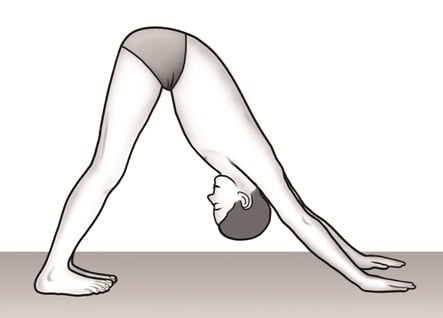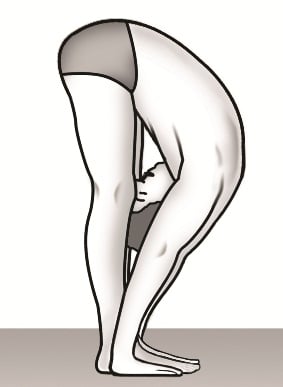In Sanskrit, surya means sun and namaskar means greeting or salutation. Surya Namaskar is then a greeting to the sun! It is an ancient ritual of twelve steps that warms up the body preparing it for yoga practice. That is why it is practiced at the beginning of a yoga class. This warming sequence has a rich history and holistic benefits for the body and mind.
Importance of Surya Namaskar
आदित्यस्य नमस्कारं ये कुर्वन्ति दिने दिने।
जन्मान्तरसहस्रेषु दारिद्र्यं नोपजायते।।
Aadityasya namaskaram ye kurvanti dine dine |
Janmaantarsahasreshu daridryam nopajaayate||
Meaning :It is said that the person who does Surya Namaskar is untouched by poverty for his thousand lifetimes.
The Mythology and Tradition Behind Surya Namaskar
In the Vedas, everything in the universe has a male and female side. The female side of the sun is nourishing and life-giving and in Hindu mythology depicted as Gayatri. The male side of the sun is invigorating, energy giving and activating, and in Hindu mythology depicted as Surya.
Gayatri can be likened to yin energy and Surya to yang energy. In Sun Salutations our purpose is to warm-up and invigorate the body for the following asana practice.
Opposite to common belief, Surya Namaskara Kriya is practised facing away from the rising sun. The purpose is to receive the stimulating and heating sun on your spine, as you warm up the body with Sun Salutations. Traditionally, one would greet the rising sun with a deep bow and prayer and then turn away from the rising sun to receive energy on the backside of the body.
As Surya gave life to the world through his powerful energy; heat energy energizes the body through the practice of Surya Namaskar.
Ways in which respiration (breathing) should be done during a Surya Namaskar
- Purak – Taking in a long breath .
- Rechak – Leaving out a long breath.
- Kumbhak –Holding the breath.
- Aantar Kumbhak – Holding the breath after breathing in.
- Bahir Kumbhak – Holding the breath after breathing out.
Various chants (mantras) to be done during Surya Namaskar
- Om Mitraaya namahaa
- Om Ravaye namahaa
- Om Suryaaya namaha
- Om Bhaanave namahaa
- Om Khagaaya namahaa
- Om Pushane namahaa
- Om Hiranyagarbhaaya namahaa
- Om Marichye namahaa
- Om Aadityaaya namahaa
- Om Savitre namahaa
- Om Akaarye namahaa
- Om Bhaaskaraaya namahaa
- Om Sri Savitru Surya Naaraayanaaya namahaa
Surya Namaskar Steps
There are ten different steps / positions that make a Surya Namaskar. Before doing a Surya Namaskar we should chant all the thirteen chants in the given order starting from “Om Mitraaya namahaa : Every step in Surya Namaskar is a different yoga position. During every step we have to do the ‘purak’ and rechak breathing steps alternately. Eg. Step 2- purak, Step 3- rechak- Step 4 – purak and so on to get the maximum benefit of Surya Namaskar hold yourself stable in every position for at least 10 to 15 seconds.
Position-1

Prarthanasan : Both feet touching each other, both hands joined at the center of the chest as in prayer position back and neck straight and look straight.
Breathing : Kumbhak
Benefit : Helps maintain the balance of the body.
Position-2

Continuing from the first position take your hands straight up above your head and bend slightly backwards to stretch your back. Keep your hands in prayer position (without bending your elbows). Keep your neck between your arms and looking upwards bend slightly backwards from the waist.
Breathing : Purak (While going from Position 1 to 2 slowly, start taking long breaths)
Benefit : Strengthens chest muscles which in turn help in breathing.
Position-3

Uttanasan : Continuing from 2nd position take your hands from above your head bending in the front and place your hands beside your feet on both sides. Keep your knees straight and try to touch the head to your knees.
Breathing : Rechak (Leave your breath slowly while going from Position 2 to 3)
Benefit : Makes the waist and spine flexible. It strengthens the muscles and is beneficial for the functioning of the liver.
Position-4

Ekpad prasarnasan : From the 3rd position start sitting down and take one leg backwards in full stretching position, your hands resting on the ground on either sides of the front leg. The other leg should be bent at the knee. Put the chest weight on the front knee, your eyes should be looking slightly upwards.
Breathing : Purak
Benefit : Strengthens the leg muscles and makes the spine and neck muscles flexible.
Position-5

Chaturang dandasan : Now slowly take the second leg back and beside the first. Keep the legs in line with the knees. The whole body weight should rest on the palms and toes. The foot, waist and head should be in a straight line. Look ahead towards the ground (This is also called Chaturang Dandasan because the body rests on the toes and palms)
Breathing : Rechak
Benefit : Strengthens the arms and maintains body posture
Position-6

Ashtangasan : Lower the chest towards the ground bending both arms at the elbows. The following eight organs should touch the ground, forehead, chest, both palms, both knees and both toes. (Because eight body parts touch the ground it is called Ashtangasan)
Breathing : Kumbhak (Bahirkumbak)
Benefit : Makes the spine and waist flexible and strengthens the muscles.
Position - 7

Bhujangasan : Now lift your body above the waist, bending it slightly backwards and looking backwards. Make sure your legs and thighs are touching the ground and your back is in a semi- circular position.
Breathing : Purak
Benefit : Makes the spine and waist flexible and strengthens the muscles.
(Positions 5, 6 and 7 together, strengthen the arms and reduce the fat around the abdomen and waist.)
Position- 8

Adhomukh svanasan : Now lift your waist upwards and arms fully stretched with hands and legs resting on the ground, try to touch the chin to the chest.
Breathing : Rechak
Benefit : Beneficial for spine and waist muscles.
Position-9

Ekpad Prasarnasan : Same as the 4th position with the opposite leg behind.
Breathing : Purak
Position-10

Uttanasan : Same as that in the 3rd position.
Breathing : Rechak
“After that slowly come back to Position 1. Now one Surya Namaskar is over. Everyday do at least twelve such Surya Namaskars.”
Physical Health Benefits
There are various studies emerging on the investigations of Surya Namaskar and yoga as having physical and mental health benefits. As Western and Eastern medical systems merge, the energetic benefits of Surya Namaskara also emerge. Here we look at some of these benefits and the connection between Surya Namaskar and the chakras.
Although Surya Namaskar can be practiced at any time of the day, it is best to practice at sunrise as sun rays can help revitalize the body & the mind. Surya Namaskar can be done in a 3-speed variation– slow, medium or fast pace. A slowed pace helps increase body flexibility, and a medium pace helps in muscle toning. Fast-paced rounds of Surya Namaskar are beneficial to one’s cardiovascular health and can aid in weight loss.
Surya Namaskar helps improve blood circulation and strengthen heart function. It also enhances the resting cardiovascular parameters such as systolic blood pressure, diastolic blood pressure and pulse pressure.
Surya Namaskar stimulates a rhythmic breathing process as breath is synchronized with each movement. This empties the lungs more vigorously and there is an opportunity for more oxygenated air to refill them.
More alveoli of the lungs are expanded, stimulated and then cleansed. Alveoli are a crucial part of the respiratory system associated with breathing. Alveoli are tiny, balloon-shaped air sacs. Their function is to move oxygen and carbon dioxide (CO2) molecules into and out of the bloodstream.
Through the rhythmic breathing of Surya Namaskara, the oxygen content of the blood is increased. This improves oxygenation of the body, especially the heart, and brain. The cardiac muscles also improve through this rhythmic breathing and movement.
Surya Namaskar is also beneficial for digestive health and other systems of the body as the practice of Surya Namaskar interacts with the organs of the body directly, by applying pressure, massaging, stretching and overall toning up the muscles. This aids the elimination processes of the body.
Mental Health Benefits
The practice has mental health benefits. Consistent practice of Surya Namaskar sharpens one’s ability to focus, improves self-confidence, and helps to develop self-discipline. It calms the nervous system and its consistent practice can contribute to managing anxiety, depression, and insomnia.
Going Fast or Slow?
Surya Namaskar performed at a slow pace
The slow Surya Namaskar practice is said to have a meditative effect if the breath and mind are kept in harmony. Slow paced Surya Namaskar also is beneficial in strengthening muscles and also improves the functioning of internal organs. Slow paced Surya Namaskar also helps control diastolic blood pressure. Beginners benefit greatly from a slow-paced practice as their breathing, bodily alignment and technique, and breathing coordination of each step can be focussed on.
Surya Namaskar performed at an intermediate pace
When Surya Namaskar is done at a medium pace, its effects are similar to those of aerobics with increased muscular endurance and power. A slightly faster set of 3 to 12 rounds should be done for the physical benefits. Beginners should start with 2-4 rounds at a faster pace and should add an extra round after every few days or every week to avoid exertion.
Surya Namaskar performed at a fast pace
Faster rounds of Surya Namaskar are considered as a cardiovascular workout. It helps burn excess fat from the body. Faster rounds of Surya Namaskar are considered very good as a warm-up exercise. More experienced practitioners would benefit from a faster pace as they have experience in focusing on their breathing, bodily alignment and technique, and breathing coordination of each step.
How Many Rounds, How Long?
The number of rounds to do depends on various individual factors. It depends on your current level of fitness, if any injuries or ailments are present and your level of technique. It is best to go slow, get comfortable with the steps syncing breath to movement with five to six rounds. As you build more strength and endurance, you can move to six rounds. Classically in Hatha Yoga, nine rounds of Surya Namaskar are used to warm up the body.
If you have high blood pressure, hernia, or coronary artery diseases or any wrist, shoulder, lower back injuries, you are advised to practice a modified version of Surya Namaskar found further below called the Easy Classical Surya Namaskara. Those with spine and back problems should consult a doctor before practicing Surya Namaskar. Thereafter variations should be sought from a qualified, and capable teacher.
Conclusion
Sun Salutation is an important practice in Hatha Yoga. It harmonizes the movements of your body with your breath and this rhythmic process done in the early morning has many mental, physical and energetic benefits. Various studies have shown how beneficial Surya Namaskar is for uplifting the overall health. Therefore, performing a few rounds of Surya Namaskar before starting your regular routine or practicing it on its own is essential to your yoga practice.
Guided Surya Namaskar is an excellent tool for beginners, as experts will provide you proper guidance based on your current body situation and mitigate your health problems via Surya Namaskar. Sign me up! For just Rs. 2,000* Seats filling fast. Book yours today!
*Your contribution benefits you & a host of social projects of Hari Shanker Pandey Sewa Samiti.

